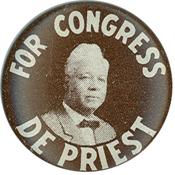African Americans Notch Record Number of U.S. House Seats in 2010 Election
However, decade-by-decade rate of growth of number of blacks in the U.S. House has stalled to its lowest level since the 1920s

However, the 2010 general election did set a new high water mark – with 41 black Americans elected to the House of Representatives last November, or 9.4 percent of the 435 voting members.
A Smart Politics review of historical election data finds that 2010’s tally narrowly eclipses the Elections of 2004 and 2006 when 40 African Americans were elected to the U.S. House (9.2 percent).
(The data in this report examines general elections in the 50 states – excluding non-voting members from Washington, D.C. and U.S. territories).
Overall, since the Election of 1870, when the first black was elected to the House of Representatives (Joseph Rainey of South Carolina), African Americans have won 678 of 28,832 seats, or 2.4 percent.
Blacks have also been elected to the House on another two-dozen occasions in special elections.
While the number of black Representatives in D.C. has hovered between 37 and 41 over the previous 10 election cycles dating back to 1992, the last decade continues a gradual upward trend that launched in the 1920s.

From 1870 through 1898, African Americans won 35 of 4,773 general elections – with several of these through hard-fought contested elections – winning at least one seat every cycle except for 1878 and 1886.
For the next 14 cycles, blacks were completely shut out – winning no seats from 1900 through the Election of 1926.
Since De Priests’ landmark victory in 1928, the number of House seats won by blacks has increased substantially across each redistricting period: from two (1922-1930), to five (1932-1940), to nine (1942-1950), to 16 (1952-1960), to 38 (1962-1970), to 78 (1972-1980), to 109 (1982-1990), to 188 (1992-2000).
And while the last five cycles set a record high for African Americans in the U.S. House – with 198 blacks elected from 2002-2010 – this marks the slowest decade-by-decade increase during this 90-year span.
African Americans won only 10 more seats during the last five cycles (198) than from 1992-2000 (188), or an increase of just 5.3 percent.
By contrast, the number of blacks elected to the U.S. House had increased by 150 percent, 80 percent, 78 percent, 138 percent, 105 percent, 40 percent, and 72 percent over the previous seven decades.
Number of African Americans Elected to the U.S. House by Decade in General Elections
|
Period
|
#
|
Seats
|
%
|
|
1870
|
5
|
243
|
2.1
|
|
1872-1880
|
19
|
1,464
|
1.3
|
|
1882-1890
|
7
|
1,639
|
0.4
|
|
1892-1900
|
4
|
1,784
|
0.2
|
|
1902-1910
|
0
|
1,948
|
0.0
|
|
1912-1920
|
0
|
2,175
|
0.0
|
|
1922-1930
|
2
|
2,175
|
0.1
|
|
1932-1940
|
5
|
2,175
|
0.2
|
|
1942-1950
|
9
|
2,175
|
0.4
|
|
1952-1960
|
16
|
2,179
|
0.7
|
|
1962-1970
|
38
|
2,175
|
1.7
|
|
1972-1980
|
78
|
2,175
|
3.6
|
|
1982-1990
|
109
|
2,175
|
5.0
|
|
1992-2000
|
188
|
2,175
|
8.6
|
|
2002-2010
|
198
|
2,175
|
9.1
|
Table compiled by Smart Politics with information from the Office of the Clerk of the U.S. House of Representatives.
With little change in the number of blacks elected over the last 10 election cycles, has the representation of African Americans nearly reached its peak in the U.S. House?
One wild card in this equation is redistricting.
In 1992, for example, blacks netted 13 more seats (38) compared to the previous cycle in 1990 (25) after new district lines went into effect.
The Class of 1992 includes several blacks now in their 10th term in the U.S. House: Sanford Bishop (GA-02), Corrine Brown (FL-03), James Clyburn (SC-06), Alcee Hastings (FL-23), Eddie Bernice Johnson (TX-30), Bobby Rush (IL-01), and Bobby Scott (VA-03).
Perhaps the forthcoming district lines for the 2012 election will create more opportunities for blacks to eclipse 2010’s mark of 41 seats won.
Number of African Americans Elected to the U.S. House by Year in General Elections, 1870-2010
|
Year
|
Number
|
Seats
|
%
|
|
1870
|
5
|
243
|
2.1
|
|
1872
|
7
|
292
|
2.4
|
|
1874
|
7
|
293
|
2.4
|
|
1876
|
3
|
293
|
1.0
|
|
1878
|
0
|
293
|
0.0
|
|
1880
|
2
|
293
|
0.7
|
|
1882
|
1
|
325
|
0.3
|
|
1884
|
2
|
325
|
0.6
|
|
1886
|
0
|
325
|
0.0
|
|
1888
|
3
|
332
|
0.9
|
|
1890
|
1
|
332
|
0.3
|
|
1892
|
1
|
356
|
0.3
|
|
1894
|
1
|
357
|
0.3
|
|
1896
|
1
|
357
|
0.3
|
|
1898
|
1
|
357
|
0.3
|
|
1900
|
0
|
357
|
0.0
|
|
1902
|
0
|
386
|
0.0
|
|
1904
|
0
|
386
|
0.0
|
|
1906
|
0
|
391
|
0.0
|
|
1908
|
0
|
391
|
0.0
|
|
1910
|
0
|
394
|
0.0
|
|
1912
|
0
|
435
|
0.0
|
|
1914
|
0
|
435
|
0.0
|
|
1916
|
0
|
435
|
0.0
|
|
1918
|
0
|
435
|
0.0
|
|
1920
|
0
|
435
|
0.0
|
|
1922
|
0
|
435
|
0.0
|
|
1924
|
0
|
435
|
0.0
|
|
1926
|
0
|
435
|
0.0
|
|
1928
|
1
|
435
|
0.2
|
|
1930
|
1
|
435
|
0.2
|
|
1932
|
1
|
435
|
0.2
|
|
1934
|
1
|
435
|
0.2
|
|
1936
|
1
|
435
|
0.2
|
|
1938
|
1
|
435
|
0.2
|
|
1940
|
1
|
435
|
0.2
|
|
1942
|
1
|
435
|
0.2
|
|
1944
|
2
|
435
|
0.5
|
|
1946
|
2
|
435
|
0.5
|
|
1948
|
2
|
435
|
0.5
|
|
1950
|
2
|
435
|
0.5
|
|
1952
|
2
|
435
|
0.5
|
|
1954
|
3
|
435
|
0.7
|
|
1956
|
3
|
435
|
0.7
|
|
1958
|
4
|
437
|
0.9
|
|
1960
|
4
|
437
|
0.9
|
|
1962
|
5
|
435
|
1.1
|
|
1964
|
6
|
435
|
1.4
|
|
1966
|
6
|
435
|
1.4
|
|
1968
|
9
|
435
|
2.1
|
|
1970
|
12
|
435
|
2.8
|
|
1972
|
14
|
435
|
3.2
|
|
1974
|
16
|
435
|
3.7
|
|
1976
|
16
|
435
|
3.7
|
|
1978
|
15
|
435
|
3.4
|
|
1980
|
17
|
435
|
3.9
|
|
1982
|
20
|
435
|
4.6
|
|
1984
|
19
|
435
|
4.4
|
|
1986
|
22
|
435
|
5.1
|
|
1988
|
23
|
435
|
5.3
|
|
1990
|
25
|
435
|
5.7
|
|
1992
|
38
|
435
|
8.7
|
|
1994
|
38
|
435
|
8.7
|
|
1996
|
38
|
435
|
8.7
|
|
1998
|
37
|
435
|
8.5
|
|
2000
|
37
|
435
|
8.5
|
|
2002
|
38
|
435
|
8.7
|
|
2004
|
40
|
435
|
9.2
|
|
2006
|
40
|
435
|
9.2
|
|
2008
|
39
|
435
|
9.0
|
|
2010
|
41
|
435
|
9.4
|
|
Total
|
678
|
28,832
|
2.4
|
Table compiled by Smart Politics with information from the Office of the Clerk of the U.S. House of Representatives.
Follow Smart Politics on Twitter.
